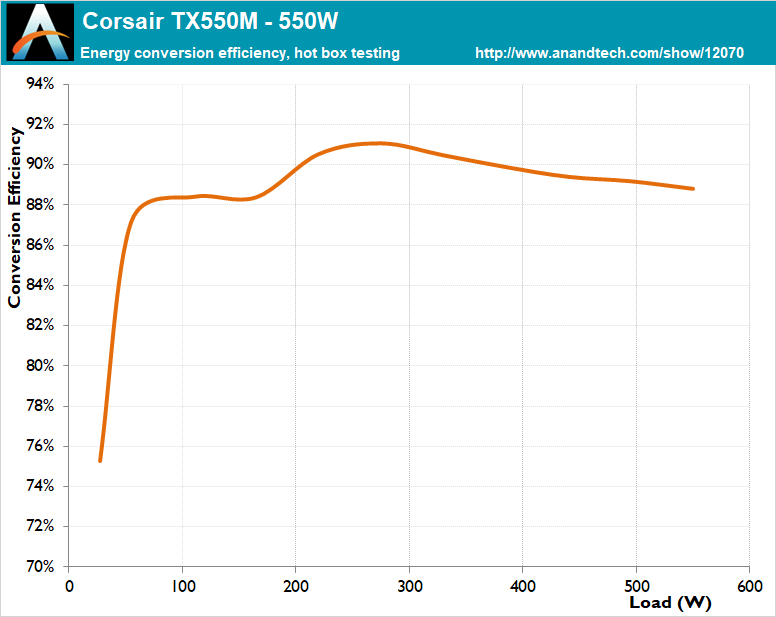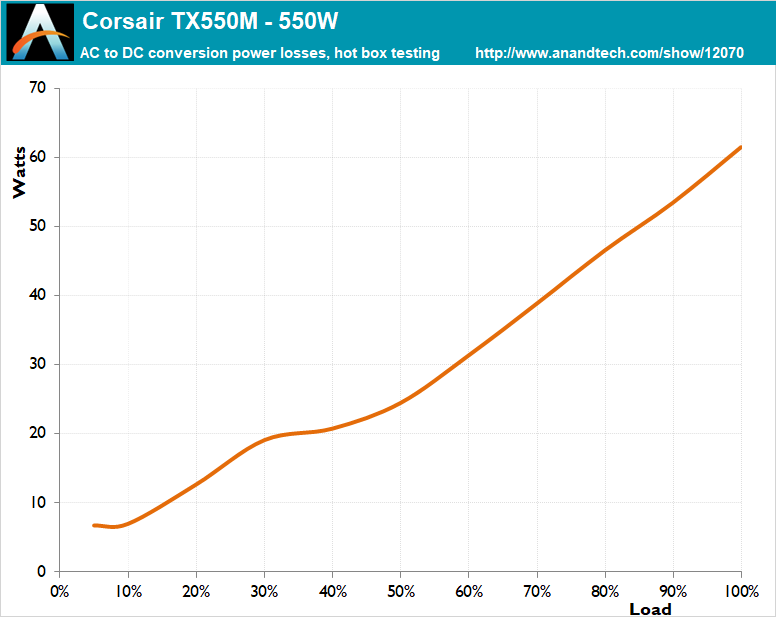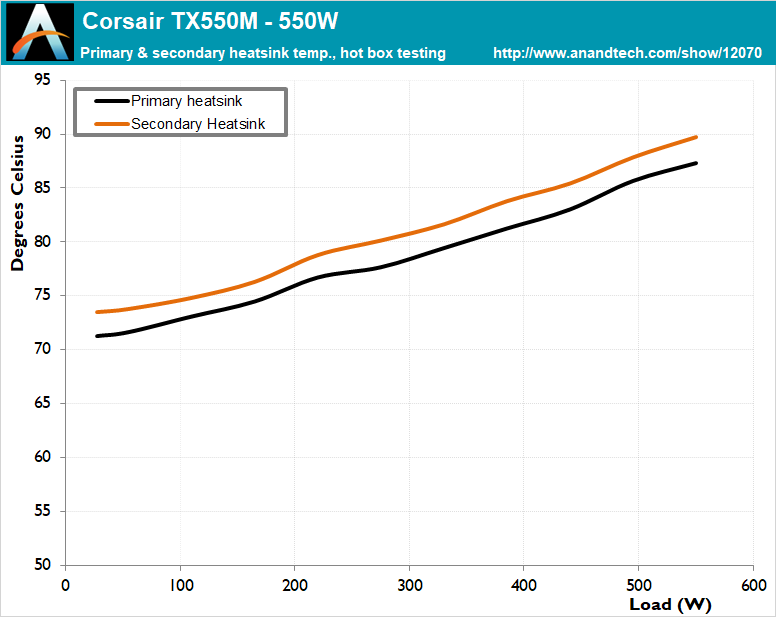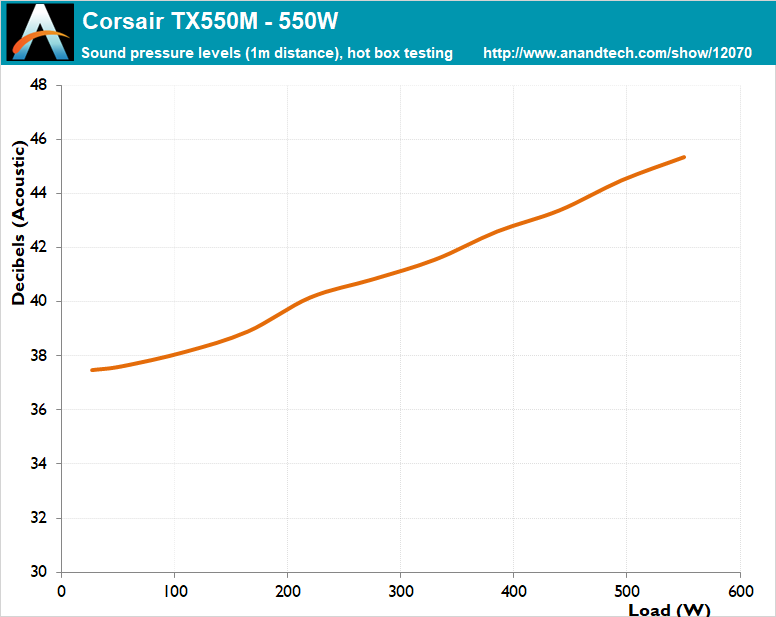The $80 Power Supply for Almost Everyone: The Corsair TX550M 80Plus Gold PSU Review
by E. Fylladitakis on December 1, 2017 8:00 AM EST- Posted in
- Cases/Cooling/PSUs
- Corsair
- PSUs
- 550W
- TX
- Modular
- Power Supply
Hot Test Results
We can see in the following tables that the electrical performance of the Corsair TX550M is very good for a mid-range PSU. Corsair definitely improved Great Wall’s designs vastly since our last encounter with them, increasing the efficiency and power quality of the platform. Although it does not impress, the maximum ripple of 36 mV on the 12V line under maximum load is a good power quality figure and satisfactory considering the price range of the PSU.
| Main Output | ||||||||
| Load (Watts) | 111.24 W | 277.4 W | 413.29 W | 549.67 W | ||||
| Load (Percent) | 20.22% | 50.44% | 75.14% | 99.94% | ||||
| Amperes | Volts | Amperes | Volts | Amperes | Volts | Amperes | Volts | |
| 3.3 V | 2.26 | 3.34 | 5.66 | 3.33 | 8.49 | 3.31 | 11.32 | 3.3 |
| 5 V | 1.81 | 5.08 | 4.53 | 5.07 | 6.79 | 5.02 | 9.06 | 5 |
| 12 V | 7.79 | 12.13 | 19.47 | 12.1 | 29.21 | 12.02 | 38.95 | 11.99 |
The TX550M appears to be a little sensitive to heavy cross-loading, with the maximum ripple on the 12V line jumping to 52 mV, but that still is a good performance figure under a highly unlikely usage scenario. The voltage regulation on every voltage line is between 1.2% and 1.4%, which is very good by today’s standards.
| Line | Regulation (20% to 100% load) |
Voltage Ripple (mV) | |||||
| 20% Load | 50% Load | 75% Load | 100% Load | CL1 12V |
CL2 3.3V + 5V |
||
| 3.3V | 1.4% | 16 | 16 | 18 | 22 | 16 | 20 |
| 5V | 1.5% | 20 | 20 | 22 | 24 | 18 | 24 |
| 12V | 1.2% | 22 | 26 | 30 | 36 | 52 | 34 |
High ambient temperatures have a measurable, but not excessive or unexpected, impact on the electrical performance of the Corsair TX550M.
The average nominal load range (20%-100%) efficiency drops by 0.7%, down to an average of 89.6%, when in a warm environment. This drop is evenly distributed across the load range, suggesting that there are no component quality or thermal stress issues. Note that the TX550M still is significantly more efficient when handling loads greater than 250 Watts.
The thermal control of the Corsair TX550M is simplistic, setting the speed of the fan mainly according to the internal temperature of the unit. Inside our hotbox, the high internal temperatures of the PSU force the fan to almost instantly reach an audible, yet typically comfortable noise level. From that point onwards, the speed of the fan is increasing almost linearly along with the load but, surprisingly, it does not ever reach painfully high noise levels. It will surely be loud at maximum load under such conditions, but we usually expect much higher noise levels from PSUs around this price range. Considering the very high ambient temperature, the internal temperature of the TX550M is good, although there definitely is room for improvement.















42 Comments
View All Comments
sweeper765 - Sunday, December 3, 2017 - link
Using 8700k OC'ed, 2x8gb ddr4 1.35v, gtx 1060, 3 hdd, 2 ssd.I get 35-40 W idle and about 270W max load.
So even 300W would be enough, though ideally for efficiency would be 550W. No need to go higher.
Oxford Guy - Saturday, December 9, 2017 - link
The optimal range for total system power is just 300 watts with a top-tier card? Yeah, right.There are two other reasons to have extra capacity in a PSU:
1) Capacitor aging
2) Lower loads on higher spec units tend to be quieter.
Oxford Guy - Saturday, December 9, 2017 - link
Another thing is that there are spikes in power usage. Sometimes transient spikes are quite a lot above the average power usage.Manabu - Monday, December 18, 2017 - link
1) Even with capacitor aging, there no need to buy a PSU more than double the max consumption of your system. So, a 300W PSU is indeed too low for a top-tier card, but a 550W one would already be more than enough. For my system with a mid-low range GPU with 250W max load (175W more normal high load) a 350W would also be plenty.2) There are platinum fanless 400W psus. Low wattage psus being noisier is just a reflect of this warped market that only valorizes high wattage psus. On the other hand, lower loads on higher wattage psus tend to be less efficient, so more heat in the ambient.
Alistair - Friday, December 1, 2017 - link
No idle fan mode, no buy. This alone shows the cooling is poor, and the noise profile will be poor. Many other better choices. Shame Corsair for not including a standard feature nowadays.Oxford Guy - Saturday, December 9, 2017 - link
This site tends to not put enough emphasis on noise. However, at least it was the only one that called out Seasonic for its terrible performance in the 1050 model that could be "heard from rooms away".Ken_g6 - Friday, December 1, 2017 - link
Why should I buy a currently-$72 Corsair, when I can get either a $55 Seasonic FOCUS Plus after rebate, or a $60 Rosewill Capstone before rebate (other versions of which are an AnandTech Editor's Choice)?oranos - Friday, December 1, 2017 - link
hard to buy anything other than seasonicairdrifting - Sunday, December 3, 2017 - link
Again there are better quality power supply for less money. Every power supply recommendation article on Anandtech has been crap so far leading me to believe you guys are just bunch of shills paid by those companies.Kyt - Sunday, December 3, 2017 - link
There are better, yes. Some of us don't have access to all brands and models and when you are choosing between only 3 brands, you would want to know what you're getting and this is where this review becomes useful.